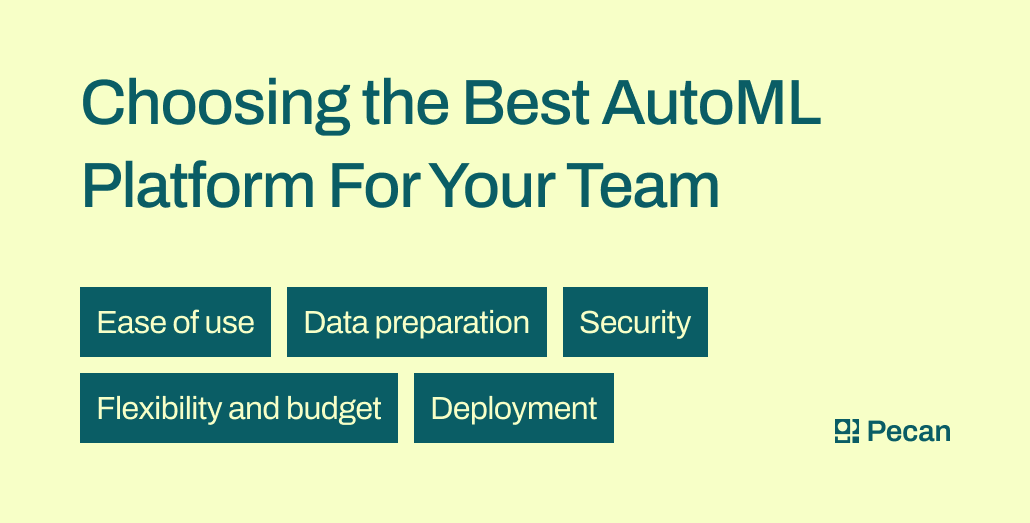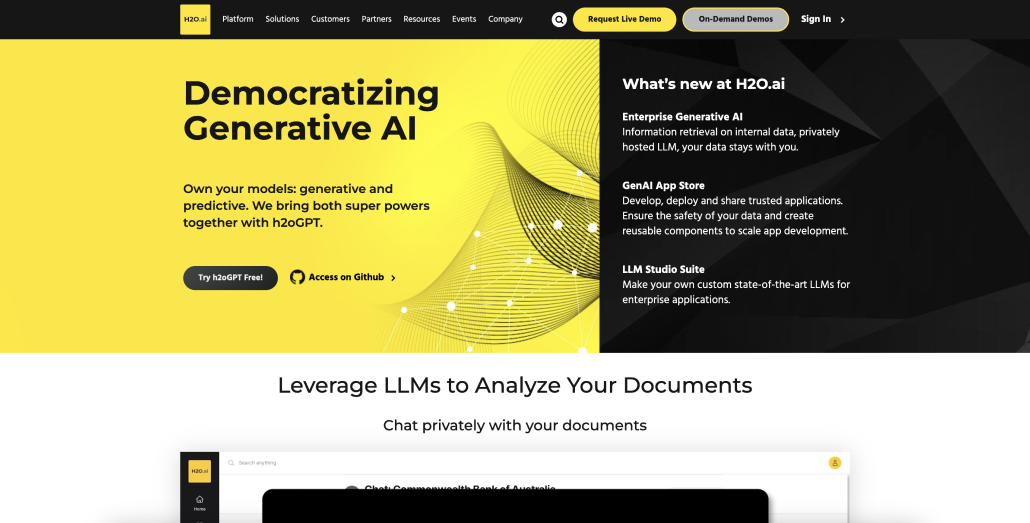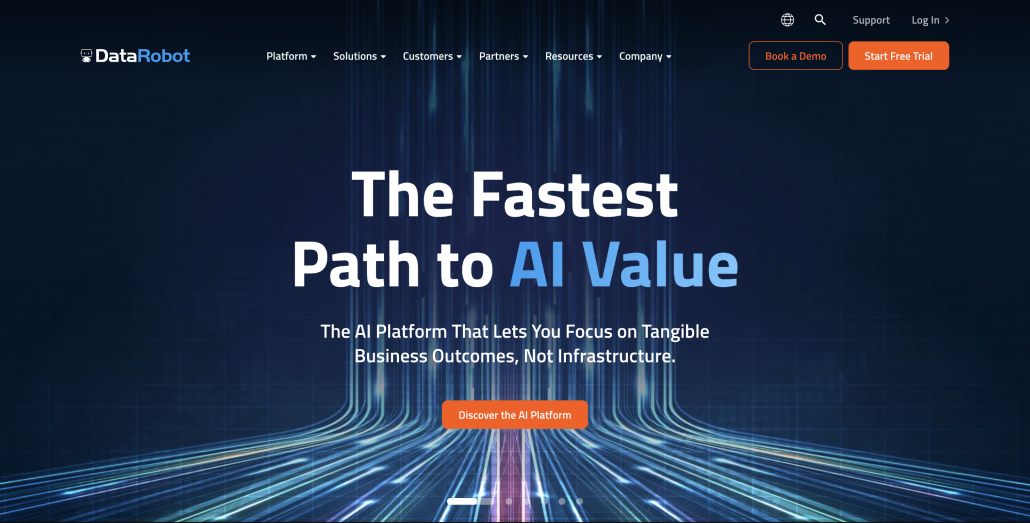In a nutshell:
- AutoML platforms automate the machine learning process without requiring coding or statistical knowledge.
- When choosing an AutoML platform, consider ease of use, data preparation capabilities, flexibility, deployment speed, and security features.
- Hand-coded models may be more suitable for use cases requiring custom logic or sensitive data.
- Popular AutoML solutions include Google Cloud AutoML, H2O.ai, DataRobot, IBM AutoAI, and Pecan AI.
- AutoML can provide deeper insights and save time, but finding the right solution is crucial for maximizing benefits.
Being a data scientist was named “the sexiest job of the 21st century,” and data science roles are projected to grow by 28% by 2026. Unfortunately, while demand is skyrocketing, the amount of skilled data science talent isn’t. With an ever-growing need for advanced analytics, organizations are turning to AI-powered solutions like automated machine learning (AutoML) platforms. But what's the best AutoML solution that fits your needs?
Whether you’re an analyst looking to level up your skills or a business leader seeking to lighten the load for the data pros on your team, AutoML solutions are here to make data science accessible and rescue those coffee-chugging, overworked data workers.
These AI-powered solutions make complex machine learning models accessible while reducing stress, strain, and busy work for your team — but before you can reap the benefits, you’ll have to choose the best AutoML platform.
94% of business leaders believe AI is critical to success.
— “State of AI in the Enterprise, 5th edition report,” Deloitte
Key Concepts for Choosing the Best AutoML Platform
Before we go into specifics, let’s define an AutoML platform: An automated machine learning (AutoML) platform is a software solution that automates all or parts of the machine learning process—including model selection, feature engineering, building, training, deployment, and monitoring—without requiring in-depth statistical knowledge or coding.
What is Machine Learning?
Machine learning encompasses a variety of mathematical techniques for “training” a computer. The computer “learns” to recognize meaningful patterns in complex datasets, which can take many forms, from numeric tabular data (like a spreadsheet) to images and text.
By identifying notable patterns in its training data, a machine learning model can look at new data it hasn’t seen before and generate a prediction about an outcome you choose for it.
For example, you can train a model using customer data including both customers who have churned and those who haven’t churned. Then, the model can look at other data where you may not know customers’ status. Finally, the model can predict how likely each customer will be to churn.
Many standard data-driven tools you use today—such as business forecasts, facial recognition, and chatbots—are built upon machine learning models. Machine learning also underlies predictive analytics, which many businesses are adopting to gain foresight about critical business decisions.
What is AutoML?
Building machine learning models no longer requires complex hand-crafted code written from scratch for every new project. Instead, researchers have designed automated ways to construct these models far more quickly — and as accurately — as in “traditional” data science. As a result, those automated approaches are much more widely available and well-regarded by data experts.
AutoML typically includes automation of:
- Data preparation: cleaning and combining data to get it into the appropriate format for machine learning
- Feature engineering and selection: determining the correct variables, plus new aggregations or combinations of variables, that will work best in modeling
- Algorithm selection: identifying the mathematical technique (model) that is best suited to the data and the outcome to predict
- Model evaluation: testing models on data they haven’t seen before in the training process to see how they will perform
- Model tuning: finding the optimal configuration of “parameters” (think of them as “settings”) for the model to help it generate better predictions, based on yourperformance metricof interest, such as accuracy
- Model selection: comparing the performance of different models with different parameters, then choosing the one generating the best results for a specific business need
- Model deployment and monitoring: integrating the model into active business processes on current data, then checking its performance regularly to ensure it continues to return value and making adjustments as needed
How is AutoML being used?
Many data scientists are finding AutoML helpful in accelerating their daily work. For example, data scientists can usenumerous Python librariesto automate different tasks in the modeling process.
In addition to using AutoML libraries, data scientists, data analysts, and business teams are increasingly turning to AutoML-powered platforms. That’s because writing brand-new code by hand for every new project isinefficient and time-consuming.
Instead, AutoML platforms give data professionals a customizable, flexible head start on their ML tasks. AutoML platforms automatically perform many of the most tedious parts of predictive modeling projects. Moreover, these platforms haveproven their abilityto perform as well or better than hand-crafted models. These advantages have led to rapid growth; the global AutoML market is projected to be worth $15 billion by 2030.
How does AutoML benefit businesses?
While all AutoML accelerates data science projects, AutoML platforms can be advantageous for businesses. This advantage largely stems from AutoML platforms allowing awider range of data and business professionalsto use data science methods.
In this situation, data scientists’ workload can shift toward more complex tasks that require advanced computational skills, while AutoML and other data professionals capably handle routine ML projects. This shift also means it may not be necessary to hire additional staff dedicated to data science—which is valuable, given that these experts are scarce and expensive.
Furthermore, AutoML’s speed and reliability mean that businesses can achieve a much faster deployment of models than traditional data science projects. That rapid deployment means they can start seeing business results sooner — in weeks instead of months or quarters. Overall, the ROI of AutoML can be quicker and greater, thanks to faster implementation and potentially lower cost.
Choosing the Best AutoML Platform for Your Team
However, many different AutoML platforms are available on the market today. To choose the right one, you’ll have to ensure it meets several key criteria.
Ease of Use
Upskilling as an analyst or lightening the workload for teams requires a solution that is intuitive and easy to use. More complexity defeats the purpose. And if you have to pay for lengthy additional training to use a solution, that also eats away at your potential ROI and business case.
With an easy-to-use solution, data workers can quickly tap into the value of machine learning, and data scientists can iterate and deploy models much faster, providing incredible business value and saving massive amounts of time. However, if implementation will be a drawn-out process and using the solution is more hassle than it’s worth, you’d be better off looking for a more intuitive solution.
Data Preparation
Data prep remains unrivaled as the single task that consumes most of data workers’ time. Since a model is only as good as the data that powers it, part of the value of AutoML is a built-in way to ingest data from various sources and streamline data preparation and cleansing, helping analysts and data scientists spend more time finding and applying insights.
So, for this criterion, consider whether the AutoML platform in question can integrate with your current data infrastructure (cloud and on-prem sources), then quickly clean and analyze your data to fuel your models.
Flexibility and budget
Some AutoML platforms specialize in very specific use cases, like predicting customer churn or pinpointing high customer lifetime value. Others may offer greater flexibility, allowing you to incorporate Python or SQL. Some have both.
It’s important to consider how much flexibility you and your team will need and answer other pertinent questions, such as how many models and use cases the AutoML solution in question can support and if it fits within your budget.
Deployment
Having the best tools in the world means nothing if they are too hard to integrate with or take months (or over a year) to deploy. So, how quickly and easily you can deploy and start using a solution is an essential factor. Integration will be far easier and faster if the solution can easily sync with your current data infrastructure.
Security
In the world of AI and data, security remains a top concern. The best AutoML platforms will have robust security features and credentials to keep your data safe and put your CIO at ease.
When an AutoML Platform Is Not the Right Answer
No tech solution is perfect for every use case. As great as AutoML solutions can be, there are situations where using hand-coded models can be more beneficial. AutoML may not be right for you if your use cases require custom logic, such as domain-specific expertise, or if your data is simply too sensitive to host on a cloud-based server. Knowing which use cases you want to support with an AutoML platform is vital to choosing the right platform.
Is AutoML Accurate?
AutoML can be highly accurate when applied to your data in the right way. AutoML uses the same machine learning algorithms as you would apply in coding a model by hand, but via automation. AutoML can also remove human bias from the model-building process, resulting in fairer, impartial models.
Ideally, an AutoML platform would allow you to make adjustments to the model and training dataset through an intuitive, easy-to-use interface. By making it easier to iterate on your model and improve its performance, AutoML could provide more trustworthy predictions when compared to a hand-built model. The tedious, in-depth revision required for model adjustments using code can lead model builders to settle for a merely adequate model, instead of readily continuing the process of model improvement.
5 Popular AutoML Solutions
Here are several popular solutions to help you jumpstart your search for the best AutoML platform. Knowing the criteria you need will help you make a choice between finalists.
AutoML Solution #1: Google Cloud AutoML
What it’s great at: Allows users to train ML models and make predictions on a specific data set. It provides sophisticated ML techniques and algorithm support.
How it works: Google Cloud AutoML works by gathering the data, preparing it, ingesting tabular data for predictive models, and then testing metrics for accuracy. It also offers automation for many parts of the analytics lifecycle, including data preparation.
Areas of limitation: Some users have concerns regarding Google’s privacy policy regarding private data sets.
AutoML Solution #2: H2O.ai
What it’s great at: Designed for a technical audience at large enterprises, H20 gives users access to many open-source machine learning algorithms.
How it works: Allows users to build models using R, Python, or a web GUI. Also features data preprocessing capabilities.
Areas of limitation: H2O.ai can consume a lot of memory depending on the size of your data and may lack documentation or extensive feature engineering capabilities.
AutoML Solution #3: DataRobot
What it’s great at: Accelerating and democratizing data science with a library of hundreds of open-source machine learning algorithms
How it works: DataRobot includes tools for data prep, automated machine learning, deployment, monitoring, and managing AI models.
Areas of limitation: DataRobot may have high licensing costs and can be highly complex for first-time users. Deployment may also require significant resources and time.
AutoML Solution #4: IBM AutoAI
What it’s great at: Automates the end-to-end machine learning process, including data preparation, model development, feature engineering, and hyperparameter optimization. Displays model candidates in minutes while ranking them on a leaderboard.
How it works: It analyzes data and uses data algorithms, transformations, and parameter settings to create predictive models.
Areas of limitation: May lack high enough degrees of customization for specific use cases and teams.
AutoML Solution #5: Pecan AI
What it’s great at: Providing accurate predictive analytics for marketing and sales teams. Also offers low-code, SQL-based features for high levels of customization.
How it works: Pecan specializes in AI-powered predictive analytics for digital marketers and empowers analysts and marketers to make informed decisions to optimize campaigns, sales and marketing strategies, and revenue.
Areas of limitation: Most effective for B2C marketing teams.
Embrace the Power of Data Science
The best AutoML solution can help you find deeper insights in a fraction of the time with the power of AI, automation, and machine learning. However, to reap the full benefits, you’ll have to make sure the solution meets your essential criteria. But once you find the right path forward, your business can leap lightyears ahead of the competition.
Ready to try the best AutoML solution for your team? Schedule a demo today to see Pecan's AutoML platform in action, or start a free trial now.










